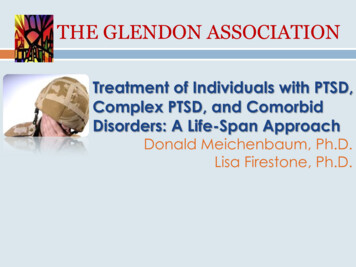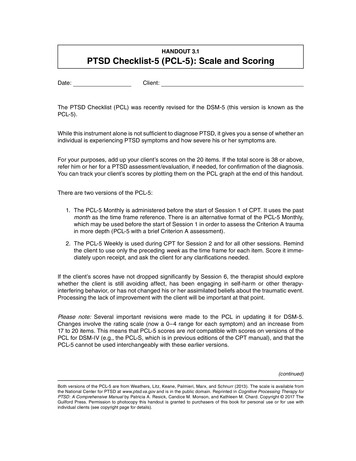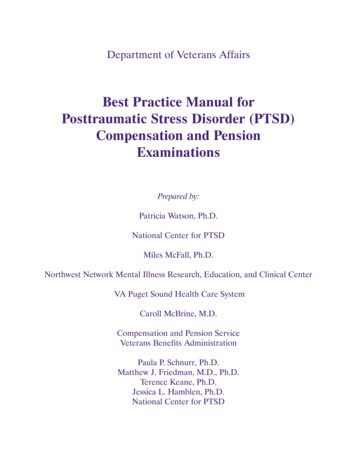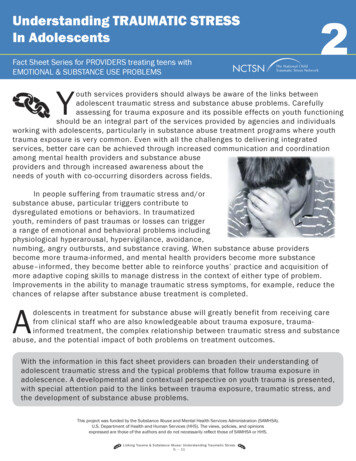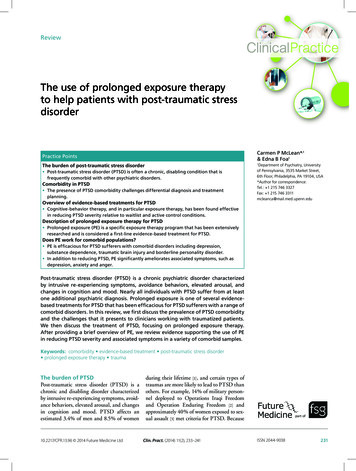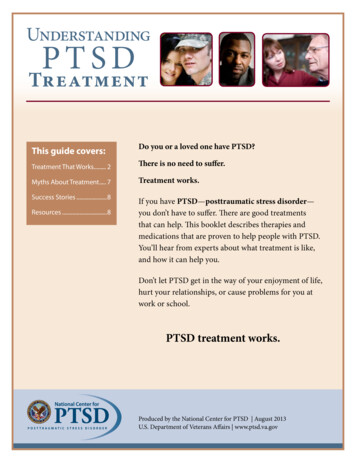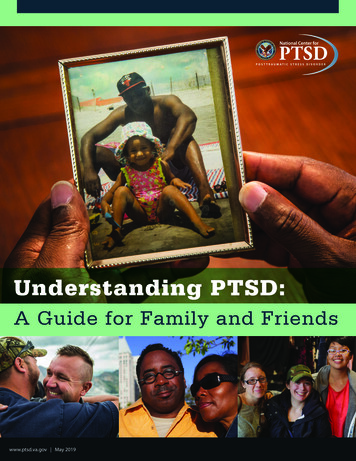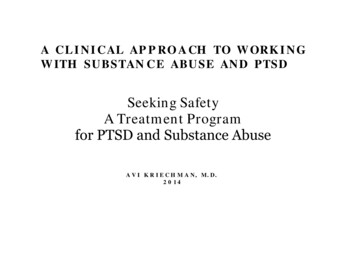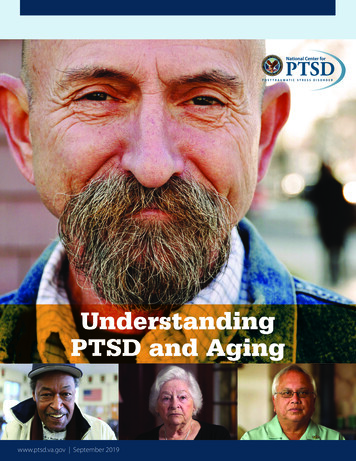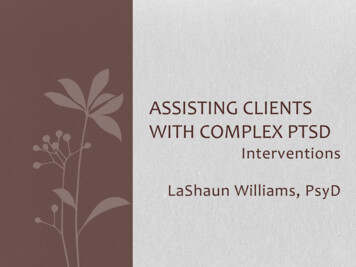
Transcription
ASSISTING CLIENTSWITH COMPLEX PTSDInterventionsLaShaun Williams, PsyD
Complex PTSDSymptom Clusters1. Re-experiencing2. Avoidance/Numbing3. Hyperarousal PTSDComplex PTSD1. Affective dysregulation2. Impaired attention andconsciousness3. Impairment in interpersonalfunctioning4. Somatization &/or medical problems5. Compromised systems of meaning
PhasicTreatment PHASE I Stabilizing safety Psychoeducation Effects of traumaResponses as adaptationsCummulative natureTreatment processDevelop therapeutic alliance Reducing symptom acuity PHASE II Review and reconstruction oftrauma memories PHASE III Engagement in community life
PhasicTreatmentPHASE ISAFTEY: Theme of Phase IWhat does safety mean? Feeling Safe versus Being SafeVery Unsafe 1-------------------------------------------Very Safe 10Perceived SafetyActual SafetyStressResponses29Dissociation92Vermilyea (2000)
PhasicTreatmentPHASE ISAFTEY: Theme of Phase ISurvival Mode Need to react No time to thinkRecovery Mode Need to respond Must Reflect & Consider
Ongoing processPsychoeduation Facilitates transparency Facilitates collaboration Reinforces differences intherapeutic relationship OK to ask “Why?” OK to expect explanation OK to expect thoughtfulness OK to question the rationale OK to disagree
Using the 5 SensesGroundingSIGHTSOUNDLookNoticearoundsoundsthe room in theroomLook at a (e.g. fan)specificobjectListen tosoftNotice a musicspecificfeatures MintsEssentialoilsPetsCleanlaundryGingercandy
GroundingMentally Orienting Self to Present “I am safe.” “Today is Monday, May 20th, 2013” “I’m at my therapist’s office.” Observation Games How many windows in this room? How many brown things are there? How many circular things? What’s the distance between meand the bookshelf? What’s the length of the table top?
Orienting toPresentComparisonsSeparating Past and PresentSIMILARITIESDIFFERENCESIn YouFeel scaredFeel aloneCould getdisappointedAdultHave helpMore able tohandle itIn theEnvironmentWish it’sdifferentCrampedPictures on wallLots of peoplearoundIn theSituationFeel attackedFeel trappedI made thedecision to behereNot trappedIn OthersHave power over People listenmeCan find out theCouldn’treason whydisagree
ContainmentSkillsPhysical temporarily put experiencesaside, rather than allowingthem to remain unconscious
ContainmentSkillsUsing ImageryRemoving Yourself from theSituationSafe Places
ContainmentSkillsUsing ImageryRemoving the DistressingMaterial
ContainmentSkillsJournaling Contains experiences Facilitates Other TreatmentActivities Grounding Developing awareness Exploration Pro’s versus Con’s
ContainmentSkillsJournalingLevel 1: surface, factual Grounding Managing time loss Increase awareness of day today eventsLevel 2: present thoughts,feelings, impulses Therapy assignments Containment Self soothingLevel 3: present-focusedwriting related to traumamaterial
CognitiveRestructuringChallengingTrauma BasedDistortionsghts Systematically identifying andchallenging cognitive distortionsand replacing them with morepositive and accurate thoughts. Can be simple consideration ofevidence for and against thethought. Can be a more involved process “Just because we think it doesn’t make it true.”
Assessing Thoughts: NSRATIONALRESPONSEOUTCOME-At the shelter.No money inmy pocket.“There isnothing todo.”(85%)Bored(90%)“Actually, thereare plenty ofthings I could do;for example goto a meeting,write in myjournal.”Belief inautomaticthoughts(10%)-Thinking aboutsome people I “I can’tused to hangstand thiswith.boredom.”(80%)-Start cravingcocaine.Anxious(95%)Bored(30%)“It is not true thatthere is nothingAnxiousto do but the(20%)pain of boredommakes it hard tosee other thingsI could do.”Adapted from Beck, et al (1993)
Assessing Thoughts: Functional?Helpful ThinkingHarmful ThinkingConstructivePuts you together“I can learn.”DestructiveTears you apart & destroys you.“I don’t know anything.”NecessaryHelps you do what you need to.“To find out if I am HIV , I need ablood test.”UnnecessaryDoes not change anything.“What if I’m HIV ?”PositiveMakes you feel better.“I can focus on what is good in mylife or what I can do.”NegativeMakes you feel worse.“There’s so many things wrong withmy life, and there’s nothing that Ido about it.”
Label Dysfunctional Thinking Patterns Overgeneralizations “She cut me offwhen I was talking. No one wants tolisten to what I have to say.” Personalizations Taking responsibility fornegative events, beyond your control. “I ruinedthe evening because I chose the restaurantwith the bad service.” Dichotomous (All or Nothing) Thinking “If Ican’t make money like I used to, what’s thepoint in living.”
Label Dysfunctional Thinking Patterns Mind Reading “The counselor doesn’t likeme, he ignored my question in group.” Negative Future Telling Thinking that youcan see how things will be in the future andits bad. Negative Mental Filter Focusingsolely on the negative andignoring the positive.
DialecticalBehavior Therapy(DBT) Skills Mindfulness Affect Regulation Distress Tolerance Interpersonal Effectiveness
Identifying andManaging Triggers“Small things set me off, andbefore I know it, I’m thinking ofsuicide.”“When I see someone light up, theworld narrows and all I can feel isthe need to get high.”Najavits (2002)
Dialectical BehaviorTherapy (DBT)Behavior ChainAnalysis1.2.Describe the specific TARGET EVENTIdentify the specific PRECIPITATINGEVENTS3. Explain in general the VULNERABILITYFACTORS influencing the event4. Describe the CHAIN OF EVENTS leadingto the TARGET EVENT5. Identify the CONSEQUENCES of theevent6. Describe in detail alternativeSOLUTIONS7. Outline in detail PREVENTIONSTRATEGIES8. Identify REPAIR options
CrisisContinuumLEVEL OF ymptom Management/Coping SKILLSThoughts12.345FeelingsImpulsesSensations
Between Triggerand Reaction“Between stimulus and responsethere is a space. In that space isour power to choose ourresponse. In our response liesour growth and our freedom.”-Victor Frankl (Man’s Search for Meaning)
BibliographyAdams, K. (1998). The Way of the Journal: A Journal Therapy Workbook forHealing. Lutherville, MD: Sidran Press.Beck, J. S. (1995). Cognitive Therapy: Basics and Beyond. New York, NY: GuilfordPressBeck, A. T., Wright, F. D., Liese, B. S. (1993). Cognitive Therapy of SubstanceAbuse. New York, NY: Guilford PressBraun, B. G. (1988). The BASK (behavior, affect, sensation, knowledge) modelof dissociation. Dissociation, 1, 4-23.Herman, J. L. (1992). Trauma and Recovery. New York: Basic Books.Herman, J. L. (1992). Complex PTSD: A syndrome in survivors of prolonged andrepeated trauma. Journal of Traumatic Stress, 5, 377-391.Cloitre, M., Courtois, C. A., Ford, J. D., Green, B. L., Alexander, P., Briere, J.,Herman, J. L., Lanius, R., Stolbach, B. C., Spinazzola, J., Van der Kolk, B. A.,Van der Hart, O., (2012). The ISTSS Expert Consensus Treatment Guidelinesfor Complex PTSD in Adults. Retrieved from ?Section ISTSS Complex PTSD Treatment Guidelines&Template /CM/ContentDisplay.cfm&ContentID 5185Courtois, C. (2004). Complex Trauma, Complex Reactions: Assessment andTreatment. Psychotherapy: Research, Practice, Training. Vol 41, No. 4, 412425.
BibliographyInternational Society for the Study of Dissociation. (2005). [Chu, J.A.,Loewenstein, R., Dell, P.F., Barach, P.M., Somer, E., Kluft, R.P., Gelinas, D.J.,Van der Hart, O., Dalenberg, C.J., Nijenhuis, E.R.S., Bowman, E.S., Boon, S.,Goodwin, J., Jacobson, M., Ross, C.A., Sar, V, Fine, C.G., Frankel, A.S.,Coons, P.M., Courtois, C.A., Gold, S.N., & Howell, E.]. Guidelines for treatingDissociative Identity Disorder in adults. Journal of Trauma & Dissociation,6(4) pp. 69-149. Journal of Trauma & Dissociation, Vol. 6(4) 2005 Availableonline at www.informaworld.com doi:10.1300/J229v06n04 05)Kluft, R. P. (1994). Treatment trajectories in multiple personality disorder.Dissociation, 7, 63 – 76.Kluft, R. P. & Loewenstein, R. J. (2007). Dissociative disorders anddepersonalization. In G. O. Gabbard (ed.), Gabbord’s treatment ofpsychiatric disorders. 4th edn. (pp. 547-572). Washington, DC: AmericanPsychiatric Press.Linehan, M. M. (1993). Cognitive-Behavioral Treatment of Borderline PersonalityDisorder. New York, NY: Guilford Press.Loewenstein, R. L. & Welzant, V. (2010). Pragmatic approaches to stageoriented treatment for early life trauma-related complex post-traumaticstress and dissociative disorders. The Impact of Early Life Trauma onHealth and Disease: The Hidden Epidemic. Lanius, R. A., Vermetten, E. &Pain, C. Eds. Cambridge University Press.
BibliographyNathanson, D. L. (1989). Understanding what is hidden: Shame in SexualAbuse. Psychiatric Clinics of North America, 12 (2), 381 – 388.Nathanson, D. L. (1992). Shame and pride: affect, sex, and the birth of the self.New York, NY: W. W. Norton & Company, Inc.Najavits, L. M. (2002). Seeking Safety: A Treatment Manual for PTSD andSubstance Abuse. New York, NY: Guilford Press.Ogden, P., Minton, K., & Pain, C. (2006). Trauma and the Body: A SensorimotorApproach to Psychotherapy. New York, NY: W. W. Norton & Company, Inc.Saakvitne, K. W., Gamble, S. G., Pearlman, L.A., & Lev, B. (2000). RiskingConnection: A training curriculum for working with survivors of childhoodabuse. Lutherville, MD: Sidran Foundation Press.Salter, A. (1995). Transforming Trauma. Thousand Oaks, CA: Sage Publications,Inc.Schwarz, R. (2002). Tools for Transforming Trauma. New York, NY: Routledge.Vermilyea, E. G. (2000). Growing Beyond Survival: A Self-Help Toolkit forManaging Traumatic Stress. Baltimore, MD: Sidran Foundation Press.
THANK YOUImage from Louisiana Tech University CounselingLaShaun Annette Williams, PsyD(202) s.com
Complex PTSD 1. Re-experiencing 2. Avoidance/Numbing 3. Hyperarousal 1. Affect
